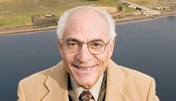Farouk El-Baz awarded membership in Morocco’s Academy of Sciences and Technology
Farouk El-Baz, director of BU’s Center for Remote Sensing, was appointed to Morocco's Academy of Sciences and Technology.

The king of Morocco, H. M. Mohamed VI, recently honored Farouk El-Baz, a research professor and director of Boston University’s Center for Remote Sensing, with membership in the Academy Hassan II of Sciences and Technology of the Kingdom of Morocco. El-Baz attended the inaugural session of the academy in Rabat on May 18, 2006.
Comprising 50 members, half from Morocco and half from abroad, the academy was created to “strengthen the role of science and technology in society and to encourage and facilitate cooperation and fruitful dialog between members of the international scientific communities worldwide.” Within the academy are “colleges” grouping people with closely related expertise to deal with important scientific issues. El-Baz is a member of the college on Environment, Earth and Oceans.
A geologist and a veteran of NASA’s Apollo lunar exploration program, El-Baz has devoted the past 30 years to the study of the origin and evolution of desert landforms. He was a member of the Apollo lunar exploration team from 1967 to 1972, serving as secretary of the Landing Site Selection Committee, principal investigator of Visual Observations and Photography, and chairman of the Astronaut Training Group. In 1973 he was appointed principal investigator of the Earth Observations and Photography Experiment on the Apollo-Soyuz Test Project, the first collaborative American-Soviet space mission.
El-Baz later served as science advisor to both the late Anwar Sadat of Egypt and King Hussein of Jordan, while continuing his research in the United States. It was then he began his desert research. His work developed a cohesive picture of how arid lands originate and evolve and helped dispel the misconception that deserts are man-made. In 1986 El-Baz joined Boston University to found and direct the Center for Remote Sensing, which under his leadership has developed into a leading force in the application of remote sensing technology internationally. In 1997, NASA named it a Center of Excellence in Remote Sensing.